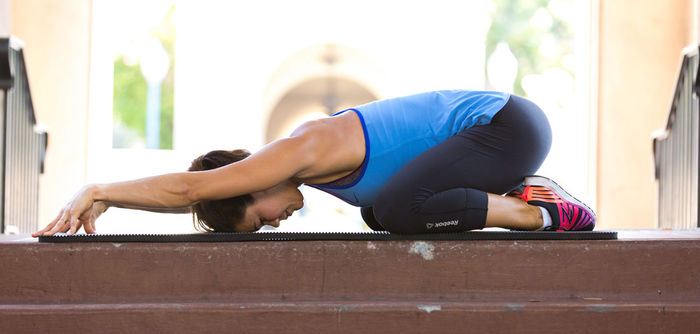Group fitness instructors often look to other clubs to find opportunities to teach the same classes and increase their income. To be sure, doing the same thing at other clubs can increase revenue, but here are some more creative—and non-traditional ways—to secure more group fitness classes.
1. Understand Your Lowest Common Denominator (LCD)
What are the general job descriptions of the classes that you want to teach? Do you teach aqua or land-based movement? Do you teach traditional shod or mind-body barefoot work? Do you specialize in cardiovascular, strength/endurance, flexibility or fusion programming? If you teach a branded program such as Zumba or Les Mills, for example, you can obtain job descriptions from these companies. If you create your own signature programs, then you must be able to explain the classes in detail. Finally, if you teach more than one style of class, make a list of all of the possibilities as you continue with the next steps.
2. Prepare
Have a friend record five minutes of the start, middle and end of a class you currently teach that you consider your best. Watch the clip three times, first with the volume off to make sure all of your visual cues are consistently as specific as they can be. The second time, watch with the volume up, but your eyes closed to make sure all of your auditory cues are consistently specific and positive. The third time, make notes on the things you could do better when you next teach that format.
3. Find the Competition and Learn
Competition can be healthy. Using your LCD list, identify the best instructors in your area who teach anything even remotely resembling your LCD. Take their classes and make objective checklists of what makes them the best in the city for your LCD. Return to your checklist from Step 1 above and add practical action items that you could do to become more like these instructors. There is no point in trying to get more classes if they aren’t as strong as they could be.
4. Hire a Mentor
Mentors do not have to be people who teach what you currently teach, but who teach how you want to teach. Explain to the individual that you are looking for a mentor, and offer reasons why you are approaching him or her so he or she knows you are doing your homework as you try to increase your class load. Top mentoring instructors are often so in-demand by clubs that they have to say “no” to teaching more classes, which means they often know when clubs are seeking dynamic instructors for popular timeslots. When you work with such a mentor, it can be like working with an agent who is out there helping you scout the area for more work.
Ask the mentor if you could assist him or her in various classes throughout your city. In this symbiotic relationship, the mentor gets assistive, free labor and you get recognition coupled with under-the-wing public visibility (and implicit approval). When it comes time for that mentor to need a sub, which invariably happens, you will be the logical choice because you already know the format, the people and the club culture.
5. Align Yourself With a Charity
Your charity of choice should reflect something important to you in terms of its message, community and outreach. Think of ways in which you can pair your love of fitness to assist the organization’s leaders, outreach or both. When you volunteer your time, you gain recognition as someone whose work makes the world a better place, all while increasing your public exposure. Align yourself with those who are the heads and directors of the charity and invite them to attend your classes. Once you have a high-profile student in your class who is convinced of your message, you are securing the voice of a public figure whose name the community (or even state and country) respects for its connection to the charity.
6. Draw on the Participants You Already Have
The students who currently attend your classes know others who could also benefit from what you have to offer. Ask them to invite others, even as one-time guests, to see how fun successful movement experiences can be. In effect, you are asking for professional matchmaking. Your classes will build and, possibly, outgrow the space of the classrooms, thus requiring the clubs to give you additional timeslots to teach the same classes for the overflow of students.
7. Expand How You Deliver Your LCD
If you teach only strength formats and feel uncomfortable teaching cardiovascular conditioning, for example, you can still explore new methods of addressing the strength/endurance mode of group fitness. Explore specialty training that ACE and others offer via both live and online learning. Doing so enables you to teach the same class type, but with a wider range of options, including specialty equipment (like bands, BOSUs and balls), isometric exercises, body-weight core training, circuit formats, partner exercises, and even mindful disciplines.
8. Get on the Substitution Lists
Whether you try this at your home club or at a club where you are not currently employed, getting added to the paper and online sub lists can boost your exposure to teach different types of classes. Remember, the more versatile you are as an instructor, the greater the chances that they will call you to teach classes that are not your regular ones. If you ever have been an instructor desperate to find a substitute teacher in an emergency, you know how valuable it can be to find new names added to the “sub list,” so consider trying to make yourself one of these “new subs” at different clubs. It also can serve as the next step to getting assigned a regular class.
9. Create a Team-taught Special Event
Find the popular instructors, both in the clubs where you teach and in the ones you researched in step #2 above. Propose a team-taught specialty class combining your strengths from different LCDs. For example, if you teach yoga, consider finding the most popular boot-camp instructor, either in your club or elsewhere. Create a special event, at your club and/or at the other instructor’s club, featuring a boot-camp/yoga experience—the yoga of the second half stretches out the muscles used during the strength/endurance portion. If you teach aqua, consider finding the most popular cycle instructor in the city and create a triathlon-like event in which you give participants cardio (via the cycle) followed by strength exercises in the pool. This type of exposure offers great possibilities and opportunities for teaching regular classes.
10. Talk to the Managers of the Clubs Around Town
Let everyone know that you would like to teach more classes. Asking the universe to send you more classes often proves wise, but you also need to tell those who make the decisions to ensure that the universe hears you.
Lawrence Biscontini, M.A., has been teaching and subbing group fitness classes in the United States and beyond for several decades, and received the ACE Instructor of the Year Award in 2002. Lawrence’s book, Cream Rises, details the outstanding things that personal trainers and group fitness instructors can do to set themselves apart from the competition in the start and finish of the sessions they conduct, including getting more classes. Find Lawrence at www.findLawrence.com.




 by
by 








 by
by